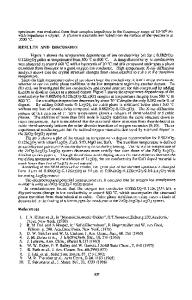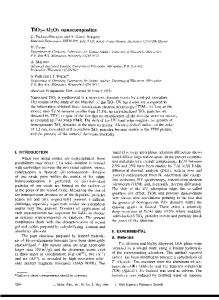Tunable luminescence from Sm 3+ , Ce 3+ codoped Al 2 O 3 -La 2 O 3 -SiO 2 glasses for white light emission
- PDF / 788,916 Bytes
- 5 Pages / 584.957 x 782.986 pts Page_size
- 86 Downloads / 302 Views
3+, Ce3+ codoped Al2O3–La2O3–SiO2 glasses were prepared and their luminescence properties were characterized. Blue-cyan to orange-red tunable luminescence was observed from these glasses with different excitation wavelengths ranging from 385 to 410 nm. White light emission with internal luminescence efficiency 42% has been observed using commercially available purple light-emitting-diode excitation. The energy transfer between Ce3+ and Sm3+ has also been investigated from fluorescence decay curves and spectral properties.
I. INTRODUCTION
Recently, InGaN-based solid state lighting (SSL) has become an important research field to many researchers, which shows many advantages (long lifetime, small bulk, toxicity-free, energy-saving, etc.) in comparison with incandescent and fluorescent lamps.1 Now, the luminescence efficiency is higher than that of the incandescent lamps and is expected to have luminescence efficiency much higher than conventional fluorescent lamps in the near future.2,3 Blue, green, and yellow phosphors have been studied extensively for their applications in the SSL fields.4–7 However, excellent orange/red-emitting phosphors are still lacking. According to colorimetric theory, red phosphors have an important role to realize ideal white light.8 Therefore, orange/red-emitting phosphors are in demand for the development of efficient white light-emitting diodes (LEDs).9 Bright red phosphors are, however, very difficult to fabricate due to their quantum yield drop with increasing Stokes shift. The luminous flux from one white LED is still so small and many white LEDs are necessary to obtain enough brightness for general lighting. Many investigations have been carried out to solve this problem, in which an efficient method is to increase the output power of LED chips. However, this will increase the chip temperature and cause a deterioration of the resin, which is used to fix the powder phosphors onto the LED chip, and decrease the luminous efficiency and lifetime.10 Some novel durable materials without resin have been investigated by some researchers.
a)
Address all correspondence to this author. e-mail: [email protected] DOI: 10.1557/JMR.2009.0191
1730
http://journals.cambridge.org
J. Mater. Res., Vol. 24, No. 5, May 2009 Downloaded: 13 Mar 2015
(i) YAG:Ce-doped glass ceramic, which can be excited efficiently by blue LED chips and shows efficient yellow lighting.11 This yellow emission can be combined with excess blue light to realize white emission. However, the white light quality depends on the stability of blue LED chips and a complicated heat treatment process is necessary to fabricate suitable microcrystallites in the bulk glass. (ii) Oxygen-defects containing CaO–Al2O3–GeO2 glass was used to generate blue-white-red tunable luminescence with different ultraviolet (UV) light excitation.12 For this method, the luminescence efficiency is obviously lower than that of activator-doped luminescence materials, and it is difficult to realize ideal white emission with a required excitation wavelength of co
Data Loading...











